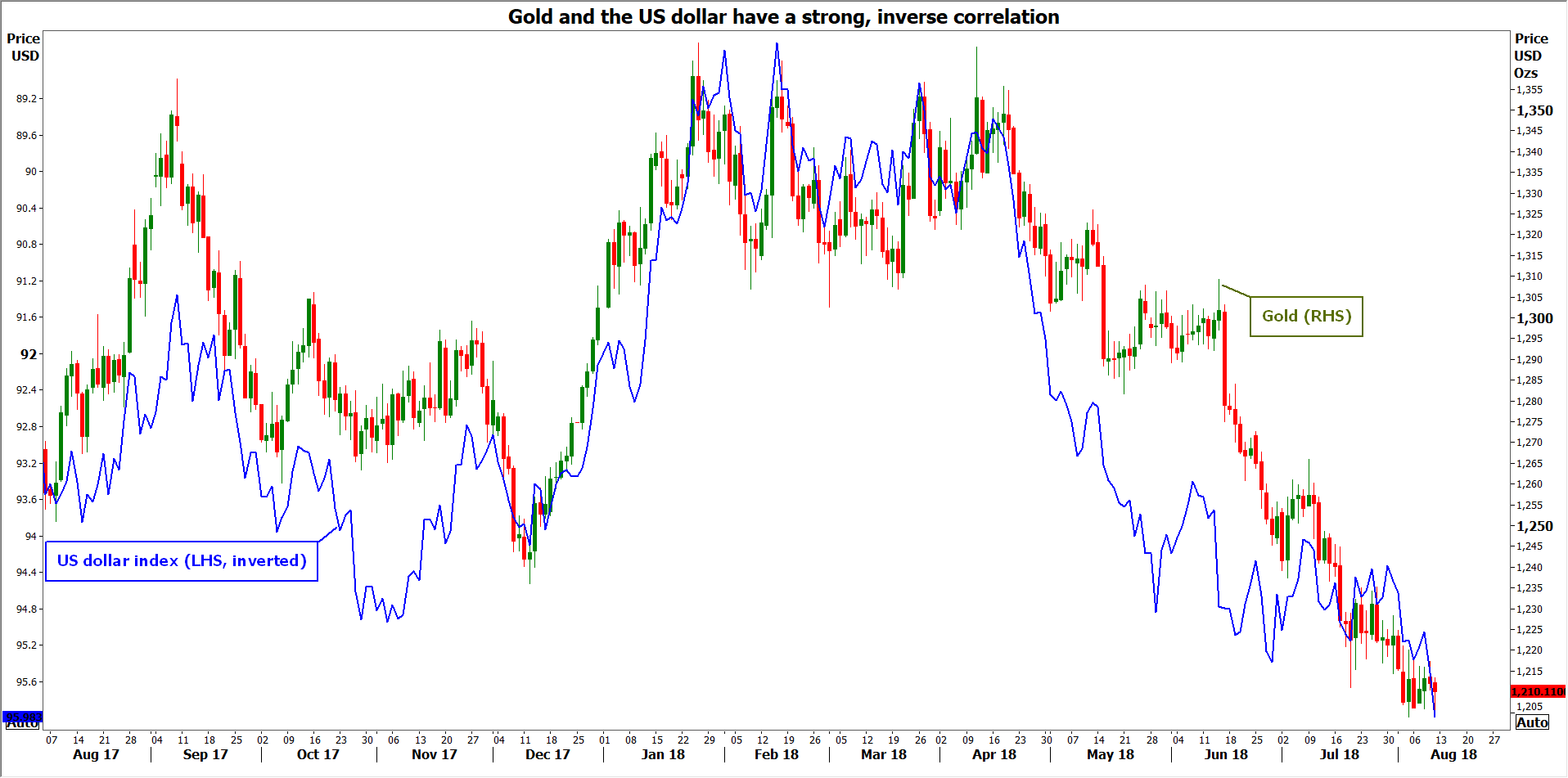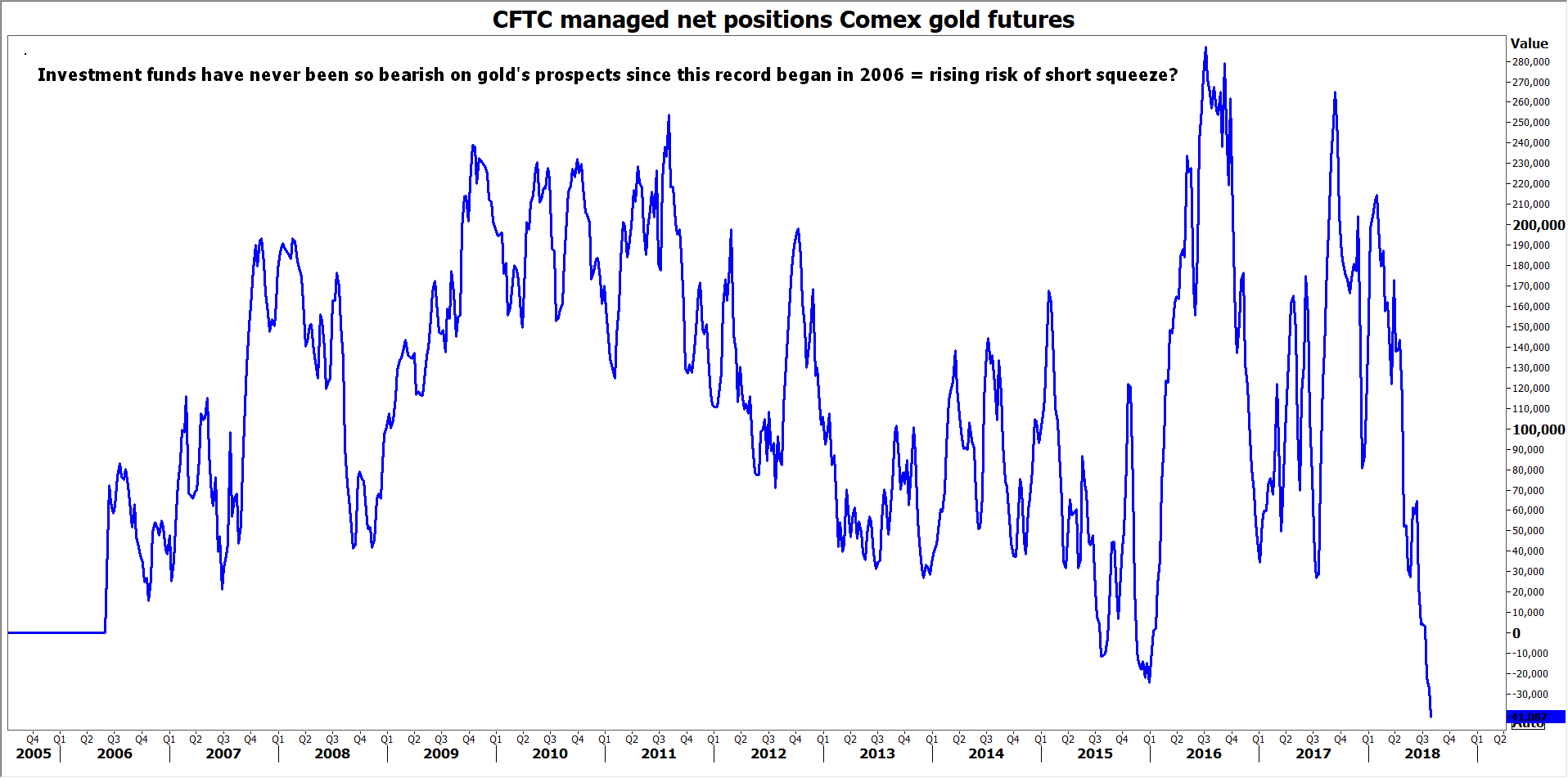Gold prices continue to hover just above their 17-month lows, as a strong US currency is casting a long shadow on the dollar-denominated metal. The safe-haven now rests at a crucial technical crossroads, with a break in either side of its latest range likely to provide short-term direction. More broadly, bearish sentiment on gold appears to be at extreme levels, which may render prices vulnerable to a “short squeeze” – implying that any piece of gold-friendly news could lead to an outsized upside reaction.
It’s safe to say that gold, like the broader precious metals complex, has had a rough year. Despite ongoing trade tensions between the world’s major economies, investors have turned increasingly bearish on the yellow metal, something owed largely to a strengthening US dollar. Since gold is denominated in dollars, an appreciating US currency renders the metal less attractive for investors that are using foreign currencies, hence diminishing its demand.
And appreciate it has – referring to the greenback. The dollar index is up by 4.2% year-to-date, partly explaining the 7.1% drop in gold prices over the same period. Beyond the strong dollar, some of the yellow metal’s troubles seem to be linked to the broader environment of rising interest rates. With the Fed and other major central banks raising rates, interest-bearing assets like bonds become much more attractive to hold relative to metals like gold, which not only pay zero interest but also carry storage costs. Hence, the logic goes, why hold gold in this low inflation environment when you can hold a US bond – that’s also considered a safe asset – and receive something back for your troubles?
Now, as for what the future holds for gold, much will probably depend on the direction in the US dollar, as well as in US bond yields. Given how much gold prices have fallen already, and how rapidly, one feels hesitant to call for further immediate downside. Especially considering that after the dollar broke new highs for the year earlier today, gold prices held up relatively well, not falling below their own recent lows. Having said that, the metal is clearly in a downtrend, and one should not attempt to pick a bottom either with prices falling so violently. As the old market adage goes: “don’t catch a falling knife”.
In such an uncertain environment, technical levels and breaks can be particularly useful in helping to determine the next directional wave in prices. To be specific, gold is currently trading near a 17-month low of $1204/troy ounce, with the area around that level also encapsulating the psychological figure of $1200. A potential downside break of that zone could confirm that the negative trend is back in force, and may be a sign of further declines. In such a case, support to declines may be found initially around $1194, the low of 10 March 2017, before the attention turns to $1180, the trough of 27 January 2017.
On the other hand, an inability of the bears to pierce below the $1200 area could indicate that the negative sentiment is losing steam, and may be an early warning that a relief bounce may be in store. In case of a break above $1220, resistance to further advances may come around the $1235 hurdle, marked by the July 26 peaks, with even steeper gains aiming for the $1265 handle, the high of July 9.
Finally, another point worthy of mention is just how bearish market positioning has turned towards gold – something that holds implications for future price action. The latest data of managed money positions (i.e. hedge funds and other large speculators) in Comex gold futures showed that in the week to July 31, net-short positions reached their highest level since records started back in 2006. In other words, funds have never been more bearish on the yellow metal, at least not over the past decade or so.
This likely renders gold prices vulnerable to a so-called “short-squeeze”. Given the extent of negative bets, any piece of news that is seen as beneficial for prices could have a disproportionally large positive effect, sending gold higher much more aggressively than normal as numerous market participants rush to either cover, or unwind their short positions.
Such a reaction could ensue on any risk-off headlines that divert safe haven flows back into gold, such as some escalation on the geopolitical front or financial contagion in Turkey that spills over into the European banking sector, for instance. The precious metal could also gain indirectly in case of a major event that triggers a flight to safety. Should investors flock to US bonds, that could push down on US yields and decrease the appeal of the dollar – thereby rendering gold more attractive.
Forex trading and trading in other leveraged products involves a significant level of risk and is not suitable for all investors.
Recommended Content
Editors’ Picks
AUD/USD posts gain, yet dive below 0.6500 amid Aussie CPI, ahead of US GDP

The Aussie Dollar finished Wednesday’s session with decent gains of 0.15% against the US Dollar, yet it retreated from weekly highs of 0.6529, which it hit after a hotter-than-expected inflation report. As the Asian session begins, the AUD/USD trades around 0.6495.
USD/JPY finds its highest bids since 1990, approaches 156.00

USD/JPY broke into its highest chart territory since June of 1990 on Wednesday, peaking near 155.40 for the first time in 34 years as the Japanese Yen continues to tumble across the broad FX market.
Gold stays firm amid higher US yields as traders await US GDP data

Gold recovers from recent losses, buoyed by market interest despite a stronger US Dollar and higher US Treasury yields. De-escalation of Middle East tensions contributed to increased market stability, denting the appetite for Gold buying.
Ethereum suffers slight pullback, Hong Kong spot ETH ETFs to begin trading on April 30

Ethereum suffered a brief decline on Wednesday afternoon despite increased accumulation from whales. This follows Ethereum restaking protocol Renzo restaked ETH crashing from its 1:1 peg with ETH and increased activities surrounding spot Ethereum ETFs.
Dow Jones Industrial Average hesitates on Wednesday as markets wait for key US data

The DJIA stumbled on Wednesday, falling from recent highs near 38,550.00 as investors ease off of Tuesday’s risk appetite. The index recovered as US data continues to vex financial markets that remain overwhelmingly focused on rate cuts from the US Fed.


